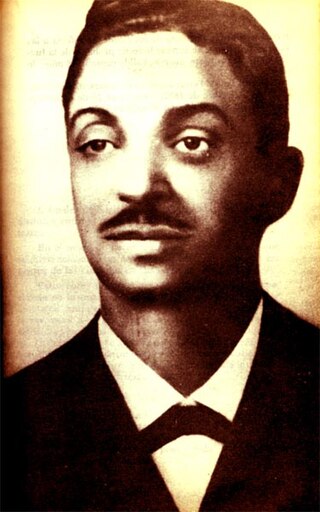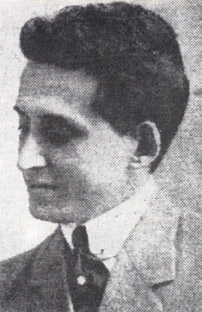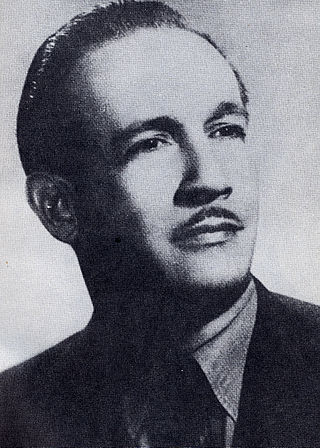Related Research Articles
The music of Cuba, including its instruments, performance, and dance, comprises a large set of unique traditions influenced mostly by west African and European music. Due to the syncretic nature of most of its genres, Cuban music is often considered one of the richest and most influential regional music in the world. For instance, the son cubano merges an adapted Spanish guitar (tres), melody, harmony, and lyrical traditions with Afro-Cuban percussion and rhythms. Almost nothing remains of the original native traditions, since the native population was exterminated in the 16th century.

Ernesto Lecuona y Casado was a Cuban composer and pianist, many of whose works have become standards of the Latin, jazz and classical repertoires. His over 600 compositions include songs and zarzuelas as well as pieces for piano and symphonic orchestra.
The guaracha is a genre of music that originated in Cuba, of rapid tempo and comic or picaresque lyrics. The word has been used in this sense at least since the late 18th and early 19th century. Guarachas were played and sung in musical theatres and in working-class dance salons. They became an integral part of bufo comic theatre in the mid-19th century. During the later 19th and the early 20th century the guaracha was a favourite musical form in the brothels of Havana. The guaracha survives today in the repertoires of some trova musicians, conjuntos and Cuban-style big bands.
Contradanza is the Spanish and Spanish-American version of the contradanse, which was an internationally popular style of music and dance in the 18th century, derived from the English country dance and adopted at the court of France. Contradanza was brought to America and there took on folkloric forms that still exist in Bolivia, Mexico, Venezuela, Colombia, Peru, Panama and Ecuador.
"Quiéreme mucho" is a criolla-bolero composed in 1911 by Gonzalo Roig with lyrics by Ramón Gollury and Agustín Rodríguez. The song was inspired by Roig's wife, Blanca Becerra, and premiered in Havana in 1911 without much success. In 1917, it was included in the sainete El servicio militar obligatorio and performed by Becerra and Rafael Llorens to critical acclaim. Roig published and sold the rights to the song in 1921, and the first recording was made in the United States by singer Tito Schipa in 1923. The English version, "Yours", was published in 1931 in the United States. It featured lyrics in English written by Albert Gamse and Jack Sherr. Both versions have been extensively recorded and arranged by different musicians, becoming Latin music standards.

Rita Aurelia Fulcida Montaner y Facenda, known as Rita Montaner, was a Cuban singer, pianist and actress. In Cuban parlance, she was a vedette, and was well known in Mexico City, Paris, Miami and New York, where she performed, filmed and recorded on numerous occasions. She was one of Cuba's most popular artists between the late 1920s and 1950s, renowned as Rita de Cuba. Though classically trained as a soprano for zarzuelas, her mark was made as a singer of Afro-Cuban salon songs including "The Peanut Vendor" and "Siboney".
Early Cuban bands played popular music for dances and theatres during the period 1780–1930. During this period Cuban music became creolized, and its European and African origins gradually changed to become genuinely Cuban. Instrumentation and music continually developed during this period. The information listed here is in date order, and comes from whatever records survive to the present day.

Miguel Faílde Pérez was a Cuban musician and bandleader. He was the official originator of the danzón, composer of the first danzón, Las alturas de Simpson, and the founder of the Orquesta Faílde.

Adolfo Columbo was a leading singer in the Alhambra Theatre in Havana, and also an actor and a leading personality in the theatre. Colombo was the most recorded artist in Cuba up to 1925: records show he recorded about 350 numbers between 1906 and 1917.

Juan de Dios Alfonso Armenteros, was a black Cuban band leader, composer and clarinetist. He founded the small orchestra Flor de Cuba, which played at dances and in theatres in the middle 19th century in Havana.
Rodrigo Prats was a Cuban composer, arranger, violinist, pianist and orchestral director.
Jorge Anckermann was a Cuban pianist, composer and bandleader. Havana-born, he started in music at eight with his father. At age ten he was able to substitute in a trio. In 1892, he went to Mexico as musical director of the bufo company of Nachos Lopez, visiting various Mexican states, and touring California.

Raimundo Valenzuela de Leon was a leading Cuban trombonist, composer and bandleader.
Claudio Brindis de Salas Monte was a violinist and double bass player who directed the most famous Cuban dance orchestra of his day. His band, the Concha de Oro, founded in the early 19th century, was the most popular band of its time. It played the dance music of the epoch at the balls of the island's aristocracy: contradanzas, minuets, rigadoons, quadrilles, lancers, waltzes. Concha de Oro was basically a típica, or wind orchestra, which was sometimes augmented to 100 players for special occasions such as fiestas.

Eliseo Grenet Sánchez was a Cuban pianist and a leading composer/arranger of the day. He composed music for stage shows and films, and some famous Cuban dance music. Eliseo was one of three musical brothers, all composers, the others being Emilio and Ernesto (1908–1981). Emilio went on composing even after having a leg bitten off by a shark in 1930; Ernesto was a drummer who became leader of the Tropicana's orchestra.

Moisés Simons, was a leading Cuban composer, pianist, and orchestra leader. He was the composer of El Manisero which is considered by many to be the most famous piece of music created by a Cuban musician and has since been recorded by other musicians from around the world hundreds of times.

Esther Borja Lima was a Cuban operatic soprano and actress.
Olga de Blanck y Martín was a Cuban pianist, guitarist and composer. She was born in Havana, the daughter of Hubert de Blanck and Pilar Martín.
Throughout the years, the Cuban nation has developed a wealth of musicological material created by numerous investigators and experts on this subject.
Manolo Álvarez Mera(néManuel Ernesto Álvarez-Mera 7 November 1923 Havana, Cuba – 16 October 1986 New York City) was a Cuban-born tenor who flourished as a bel canto during the late 1940s and 1950s. Despite having an operatic caliber voice, he gained popularity singing in operettas, musical reviews, radio, television, vaudeville, and major night clubs in Cuba, New York, and Latin America. He became a Cuban exile in 1960 after the Cuban Revolution.
References
- ↑ list of theatres in Orovio, Helio 1981. Diccionario de la música cubana. p401 et seq.
- ↑ Díaz Ayala, Cristóbal 1994. Cuba canta y baila: discografía de la música cubana 1898–1925. p193 et seq. Colombo's last two recordings were in 1929 (Catalog of Cristóbal Díaz collection at Florida International University library)
- ↑ Robreño, Eduardo 1961. Historia del teatro popular cubano. La Habana. p15
- ↑ Leal, Rine 1986. Teatro del siglo XIX. La Habana.
- ↑ Carpentier, Alejo 2001 [1945]. Music in Cuba. Minneapolis MN. p172 et seq.
- ↑ Spanish musical form of theatrical origin; not danced
- ↑ Díaz Ayala, Cristóbal 1994. Cuba canta y baila: discografía de la música cubana 1898–1925. Fundación Musicalia, San Juan P.R. p49 and 297
- ↑ Article La zarzuela en Cuba in Orovio, Helio 1981. Diccionario de la música cubana. p440
- ↑ Carpentier, Alejo 2001 [1945]. Music in Cuba. Minneapolis MN. p218
- ↑ Leal, Rine 1982. La selva oscura, de los Bufos a la neo colonia: historia del teatro cubano de 1868 a 1902. La Habana.
- ↑ Leal, Rine 1975. Teatro siglo XIX: Antología. 2 vols, La Habana. Contains full scripts and lyrics of important examples, but no musical scores.
- ↑ Ortiz, Fernando 1950. La Afrocania de la musica folklorica de Cuba. La Habana, revised ed 1965.
- ↑ Ortiz, Fernando 1951. Los bailes y el teatro de los negros en el folklore de Cuba. Letras Cubanas, La Habana. Continuation of the previous book.